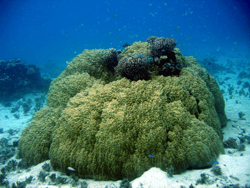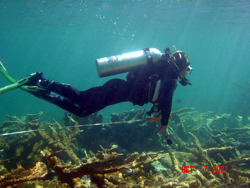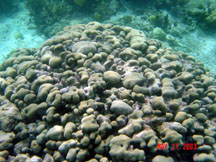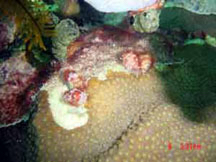Past Research
Introduction
Molecular evolution and ecology encompasses studies of process on three different time scales - affecting populations, affecting species, and affecting long-term molecular evolution. People in the Baums laboratory test ecological and evolutionary hypotheses concerning all three time scales. We focus on research projects that can contribute to both our basic understanding of ecosystems and have applications in conservation biology. Currently, we develop and apply molecular tools to understand the influence of biogeography, population structure, and mating patterns on the survival and evolution of corals and other marine organisms.
The degree to which coral reef systems are interconnected by larval exchange is one of the key issues in marine ecology and evolution today. Shallow water marine systems have experienced dramatic declines over the past few decades. Effective conservation of these systems requires knowledge on the spatial scale over which they are regulated. Traditionally, marine populations were thought to be open: passive larvae are transported long distances via ocean currents and so connect populations even at remote locations. However, recent methodological advances have produced evidence to the contrary. These results emphasize larval behavior as a means to increase retention around spawning grounds, resulting in closed populations on smaller spatial scales.
Our research on coral reproduction was featured in News Focus Article published in the journal Science (14 Dec 2007): Vol. 318. no. 5857, pp. 1712 - 1717. DOI: 10.1126/science.318.5857.1712
Temperature Adaptation in Corals
This research focuses on the effects of temperature on dispersal of a reef-building coral, a topic particularly relevant in light of global warming and the sensitivity of corals to warming temperatures. A growing body of work has demonstrated the variability and importance of algal symbiont types ("clades") in determining survival of the holobiont(the coral animal and its algal symbionts) under high temperatures, but data is not available on the contribution of the coral animal. Acropora palmata is particularly worthy of attention because it is one of two coral species currently listed as threatened under the US Endangered Species Act. By identifying signatures of selection over the range of the species, conservation efforts can prioritize source populations for restoration material based on adaptive similarity.
Dispersal of larvae via ocean currents is a common strategy among sessile marine organisms and so spatially discontinuous populations maintain a shared gene pool. Long-lived reef building corals employ such strategies to connect their shallow-water populations across stretches of inhospitable open-ocean. Increasing seawater temperatures are predicted to quicken larval development so that average dispersal distances are expected to decrease. At the same time, species currently limited by minimum annual seawater temperatures may extend their ranges pole ward in the coming years. The objectives of this project are to measure the effect of high and low seawater temperatures on early life stages and ultimately predict changes in connectivity patterns as a result of global warming. We expect that individuals and populations differ in their abilities to respond to changing environmental conditions. We are measuring such adaptive trait variation in the reef-building coral Acropora palmata by a combination of gene expression experiments and population genomics. We just completed sequencing of the A. palmata larval transcriptome using 454 sequencing technology. Microarrays and digital gene expression experiments are yielding candidate genes for temperature adaptation in corals. A large number of genome-wide single nucleotide polymorphisms (SNPs) are being developed, some within the genes identified as differentially expressed in the microarray experiment. Patterns of SNP variation will be assessed in existing range-wide samples of A. palmata and loci identified that show signatures of selection. Taken together these data will for the first time provide estimates of genome-wide adaptive trait variance in corals that can be incorporated into real-time dispersal models to predict changes in connectivity patterns as a result of global warming.
Through continuing a series of workshops held since 2005 by SECORE (SExual COral REproduction), we are helping to build a cooperative international network of public aquariums and research institutions to establish coral breeding programs for ex situ and field populations of A. palmata. The collaboration between professional aquarists and zoo scientists continues to improve larval rearing methods and these techniques are made available to other interested parties. Zoos and aquaria have effective outreach missions to educate the public about wildlife, science and conservation and reach millions of visitors annually. They can accomplish what is urgently needed in marine conservation today: making the invisible underwater world visible to people who live far from its shores. Graduate and undergraduate students are in integral part of this project and will receive training in field and laboratory work and lecture courses.
ENSO-mediated Gene Flow Across the Eastern Pacific Barrier

The geographic isolation of shallow-water tropical corals living in the eastern Pacific has stimulated much interest in their origin and evolution. As elsewhere in tropical seas, habitats formed by these corals harbor a rich diversity of associated species, and may contribute heavily to local economies via fisheries and reef-related tourism. However, coral communities in the eastern Pacific often occur where environmental conditions for reef growth are marginal. These precarious conditions have spurred interest in how reef corals persist in the eastern Pacific. Our goal is to assess one potentially critical component of this persistence: the timing and extent of demographic connections between coral populations in the eastern Pacific and populations further west, in the heart of the equatorial Pacific. To answer this question, we use novel ways of combining analyses to infer the history of isolation and connectivity between populations. Results from this research will not only answer long standing questions for marine biogeographers, but will also provide critical information for the management of coral reefs. This material is based upon work supported by the National Science Foundation under Grant No. 0550294.
The Foundation Species of Caribbean Reefs
Most reef connectivity research has been conducted on fish with highly developed larvae. However, larvae of the organisms that build the reef ecosystem, scleractinian corals, are much less able swimmers. We thus chose the foundation species of Caribbean reefs as a model organism for reef connectivity: the elkhorn coral Acropora palmata. A. palmata forms branching colonies that occur in shallow water. Similar to foundation species in other systems such as redwoods and seagrasses, A. palmata has two modes of propagation. Colonies reproduce sexually by releasing egg-sperm bundles into the water column in an annual synchronized mass-spawning event. However, asexual reproduction by fragmentation (breakage of branches) may dominate local recruitment. Both asexual and sexual means of reproduction have consequences for the conservation genetics of this imperiled species. Hence, we determined the genotypic diversity within local populations of A. palmata, and the extent to which geographically isolated populations are genetically similar throughout the Caribbean.

Most population genetic analyses assume dispersal patterns have been stable for thousands of generations, thus they commonly reflect past colonization histories more than ongoing dispersal. Recently developed multi-locus genotyping approaches, however, have the demonstrated ability to detect both migration and population isolation over far shorter time scales. Using microsatellite markers and a combination of traditional F-statistics and Bayesian analyses, we showed that populations of Acropora palmata have experienced little or no recent genetic exchange between and asymmetrical migration within the western and eastern Caribbean. Puerto Rico was identified as an area of mixing between the two subregions (Baums et al. 2005). A phylogeographic break at the Mona Passage between Puerto Rico and Hispanola is congruent with results reported for coral reef fish. However, this is the first such break described for a scleractinian coral.
Clonal Reproduction in Branching Corals

While clonal reproduction may mark an asexual strategy to secure resources, recent work on plant populations suggests low genotypic diversity may also evidence a failure of sexual recruitment that put such populations at high extinction risk. This risk is increased in isolated populations. Using highly polymorphic microsatellite markers, we showed that clonal structure varies with population structure, i.e. the western Caribbean is dominated by asexual reproduction patterns while the eastern Caribbean is more sexual (Baums et al. 2006). We argue that the level of sexual recruitment has been consistently higher in the eastern range of A. palmata than the west based on genetic and physical larval dispersal models. Most stands of A. palmata in Florida, at the northern limit of the species' distribution, were monoclonal. Several plant species show a similar pattern of dominance of asexual reproduction at their range limits. The low genotypic diversity in Florida indicates that the evolutionary potential of the coral to adapt to environmental changes may be greatly reduced in this area.
Clonal reproduction is not restricted to branching corals. In collaboration with Nicola Foster and Pete Mumby (University of Exeter), we showed that Montastraea annularis can also reproduce asexually by fragmentation (Foster et al. 2007). These finding challenge the assumption that massive corals mainly reproduce through larval dispersal. A Caribbean-wide survey of asexual reproduction in this species in underway.
Bio-physical and Genetic Models Predict Dispersal Break

In collaboration with physical and biological oceanographers at the University of Miami (Drs Claire Paris and Laurent Cherubin), we combed results of molecular work with models of larval dispersal based on the life history of the larvae and physical forcing (wind, currents) (Baums et al. 2006). The goal is to better understand the mechanisms that maintain the population structure of A. palmata. The semipermeable barrier at the Mona Passage identified by the genetic model may stem from a seasonal eddy that develops in the Mona Passage during the spawning period. This interdisciplinary approach to phylogeography and conservation genetics of marine organisms holds promise to solve the problems of estimating migration over ecologically relevant time scales.
Lack of Population Genetic Markers

Hard corals present particular challenges for population genetic studies: they frequently produce asexually, theycontain intracellular symbionts and mitochondrial DNA is nearly invariant within coral species. Ad novo development and testing of multiple single-copy microsatellite markers (Baums et al. 2005) was thus a necessary first step. Through controlled breeding experiments it was confirmed that the markers showed Mendelian inheritance, a critical assumption of population genetic models. Symbiont-free spawn was collected during the annual spawning event from marked colonies and crossed. Mendelian inheritance and coral-specificity were proved by genotyping individual larvae and comparing them to the parental genotypes.
Connectivity, Gene Flow and Oil Exposure in Deep Sea Corals
Deep-sea communities are known since the 18th century, but exploration is just starting, due to the difficult access to these systems. Most alarming is the rate in which they are disappearing due to intense fishing,bottom trawling and hydrocarbon drilling. Recent studies suggest that seamounts serve as refuges for marine fauna during glacial periods, and act as an additional source of diversity for shallow water communities. 63 species of scleractinians and 26 species of antipatharians are reported from the Gulf of Mexico, with an increasing number of species being described. We discovered that L. glaberrima shows significant population structure in the deep Gulf and that this species can reproduce asexually as well as sexually.

In May of 2010 the blowout of the Deep Horizon Platform released approximately 4.4 million barrels of crude oil to the Gulf of Mexico, and the effect of the spill and the mitigation strategies on those species is still unknown. We are interested in elucidating the effects of the spill and the early mitigation strategies on deep-sea coral populations and their microbial communities in the Gulf of Mexico. During two cruises we collected samples of L. glaberrima using submarines from depths between 300 and 800 m. We experimentally exposed black corals to light sweet crude oil as well as to the dispersant used during the clean-up efforts. We plan to develop functional genomic tools to understand how gene expression and microbial communities change in response to the spill and dispersant. These studies will provide new insight of how Cnidarians, whose members compose the foundation species of tropical and cold-water coral reefs, may cope with chemical and pollutant exposure. This work is funded by the Gulf of Mexico Research Initiative (GRI, http://niust.org/griproject/) as part of a research consortium led by Dr. Ray Highsmith (University of Missisippi), by the Bureau of Ocean Energy Management, Regulation and Enforcement (BOEMRE) and NOAA's Office of Ocean Exploration and Research (OER).
Any opinions, findings, and conclusions or recommendations expressed in this material are those of the author(s) and do not necessarily reflect the views of the National Science Foundation.